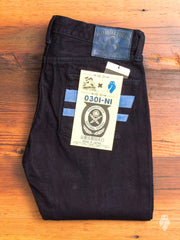 Momotaro
Momotaro
0301NI Tokushima "Going to Battle" 15.7oz Selvedge Denim
We are pleased to introduce the 0301NI from Momotaro - a special edition indigo over-dye of Momotaro's best-selling 15.7oz Vintage Label series fabric. Limited to 20 pairs worldwide, this exclusive item was over-dyed using ancient natural indigo dye from the Tokushima prefecture of Japan. As a result, many of the original details have been altered in color, such as the iconic "Going to Battle" stripes, pink selvedge and inseam, and natural leather patch. With wear, the jeans will fade to reveal the distinct shades of Tokushima indigo that make it the most coveted indigo dye in the world today.
The indigo used for this over-dye is among the rarest and oldest dyes in the world. During World War II, the art of indigo-dying was almost lost as the Japanese government required all agricultural land to be used for military purposes, prohibiting cultivation of the indigofera plant. Heisuke Sato, the most prominent indigo grower in Tokushima, continued his indigo cultivation in secret for many years despite the risk. Today his grandson, Akihito Sato, continues his lineage as a 9th generation indigo craftsman, growing the plant and preparing the dye that was used for this limited edition over-dye.
Natural indigo is a unique dye that takes months to prepare. Compared to synthetic indigo it creates a richer, deeper, more fascinating color which takes longer to fade. The costly process begins in the fall, when leaves are picked, chopped, and left in huge piles more than 60" high to ferment. Using water pumped from wells 80 meters underground, the piles are sprinkled, raked, and mixed every five days for three months, fermenting until mid December. At this point the indigo is water soluble, and ready for the dye bath. The fermented leaves are called “Sukumo”, and because they are alive with organisms, Sato says they must be treated with love to create a good color.
To prepare the dye bath the Sukumo is poured into clay vats filled with water and mixed with wood ash and lye. Lime and Sake are combined with other natural ingredients to finalize the mixture. It must be stirred several times per day to ensure fermentation. The peak of the dye is reached when bubbles begin to foam at the top of the solution. This is known as an “Indigo Blossom”, and means the dye is ready to be used. Fabric that has been dipped in the dye will come out green, and must be exposed to air to oxidize into blue. The shade of blue after one dip will be very light, and the dipping process must be repeated many times to achieve darker colors. Each shade of indigo has a unique name based on its color. Kamenozoki is the lightest shade, almost white. Asagi is a very pale shade of blue. Hanada is reminiscent of a sky blue hue. Lastly, Nokon -- the deepest color -- is achieved via multiple dips and dyes, and the color of the 0301NI from Momotaro. We are honored to offer this limited edition item as a Blue Owl Workshop exclusive.





